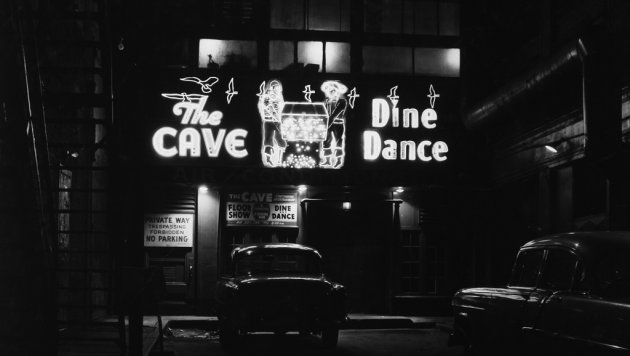Back in the day, Bostonians used to stay up later, and what's now an obscure alley drew them in

Photo between 1955 and 1959 by Nishan Bichajian. See it larger.
What's now a little used alley across Tremont Street from Lagrange Street (so obscure the Google Street Views car has never been down it) was once an entrance to a nightclub that was part of a restaurant complex where Boston's elite would meet to greet and eat - and until 3 a.m., if you can imagine.
The Schneider brothers, Joseph and Max, opened Steuben's 114 Boylston St., in 1932, after emigrating from Vienna - by way of New York.
Their new place featured what was then Boston's longest soda bar. After Prohibition was repealed the next year, Steuben's became one of the first restaurants in the city to win a liquor license - they kept the bar, but changed the beverages offered at it.
Their space stretched to Van Rensselaer Place, an alley they shared with three theaters off Tremont Street.
Eventually, they expanded Steuben's to include five separate rooms, including Club Midnight - open until 3 a.m. - and the Cave, which opened in 1942. At first, the Cave described itself as "Boston's Gayest Night Spot - in the earlier sense of the word - but eventually it became "Boston's only authentic Latin-American room," featuring Jack Fisher's Latin Band and weekly "Cha-Cha-Cha Jamborees."
In addition to Van Rensselaer Place, patrons could also get their cha-cha-cha on via an entrance on Boylston Place.
Steuben's and the Cave continued on through the 1960s and the advent of the Combat Zone. Steuben's closed sometime between April, 1966, when it took out its last help-wanted ad in the Globe, and 1968, when the Boston Licensing Board - one of whose members was Dapper O'Neil - approved a license for a new place called the Sugar Shack.
On April 22, 1965, meanwhile, the city officially renamed Van Rensselaer Place as Allen's Alley to honor Cambridge native (but Boston Public Library regular) Fred Allen, who had a regular segment on his radio about life on Allen's Alley in a fictional small town.
In addition to Steuben's, Max Schneider also operated restaurants at Suffolk Downs and at a track in Lincoln, RI - where he died of a heart attack in 1975. Joseph died in 1986.
The Steuben's name lives on - in Denver, where Max and Joseph's grand-nephew, Josh Wolkon, runs a restaurant with that name in honor of "the center of the Boston dining and nightlife scene" his uncles created.
Nishan Bichajian took the photo of the Cave's entrance sometime between 1955 and 1959 as part of a five-year MIT project funded by the Rockefeller Foundation called Perceptual Form of the City, focused on urban planning, in particular how individuals navigate large cities (photo posted under this Creative Commons license).
Ad:

Comments
Magoo sez
Magoo sez the early to bed early to rise makes Magoo happy, wealthy, and the first one to get a hot shower and drop a doogie in the morning, without the doogie seat being warm from the prior doogie dropper. Magoo.
Does Mrs. Magoo . . . .
also post.
Thought perhaps we could get both sides of this.
Love this!
I love this kind of local cultural history.
This type of entertainment establishment, . . .
should be open on all days that end in y and in multiple parts of the city. Boston used to have nightclubs* in Mattapan, South End, and South Boston with top flight entertainment.
Relatives tell me about Scollay Square, the Old Howard and a few unnamed and untamed places and acquaintances.
Before my time, but - WHAT HAPPENED TO US?
*Hi Hat and others in the So. End
Blinstrubs in So. Boston
Can't think of the name of the one in Mattapan.
Where is Costello and his Wikipedia like knowledge of Boston when you need him.
Lanes Lounge
You're probably thinking of Lanes Lounge in Mattapan @g. A combination Nightclub, Pool Hall, and Candlepin Bowling Alley all in one building although not in one venue. The bowling alley and pool hall had there own space separated from the nightclub. That place was so old school they didn't even have a pinball arcade.
No more thanks to the lost
No more thanks to the lost joy of humans being friendly to each other and socializing in person.
Timeline
I know what you're saying, but the art of socializing in public went on long after the closing of Steuben's in 1966. The end came in earnest in the early 2010s with the rise of the smart phone and the "phone based childhood" which replaced the unregulated "play based childhood" which had been in decline since the 1990s. The socializing skill was largely lost as a result.
I remember the Sugar Shack.
I remember the Sugar Shack. The Temptations played there. It's hard for me to think of that club as part of a restaurant/nightclub complex that extended all the way to the alley next to the Saxon (now Emerson Cutler Majestic) Theatre.
Together
Also, post-Sugar Shack, in the late 70s, it was a short-lived gay bar/disco called Together.
I remember the Sugar Shack too.
Being a city kid, when I saw a pancake house called The Sugar Shack up in the woods of Vermont, it was a revelation for me.
Nowadays, we're lucky to get
Nowadays, we're lucky to get one half-decent Cha-Cha-Cha Jamboree a year.